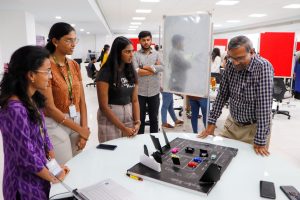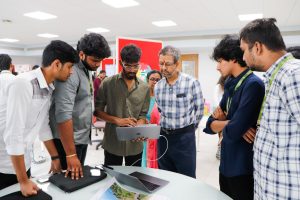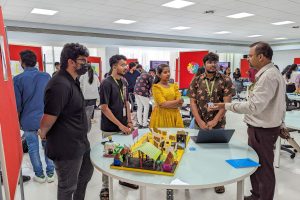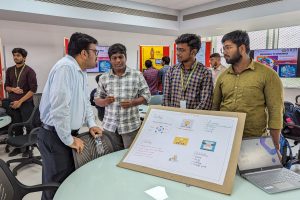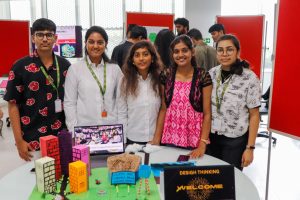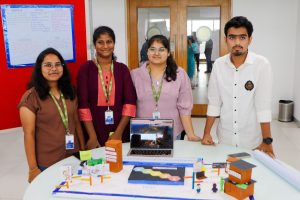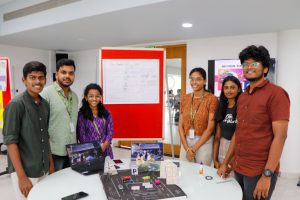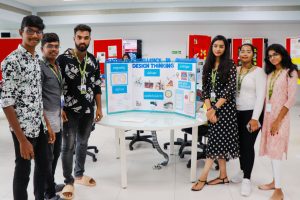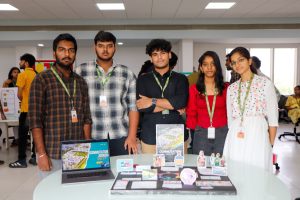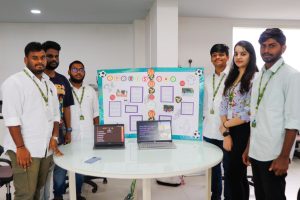A Novel IRS-relay Network for ITS with Nakagami-m Fading Channels
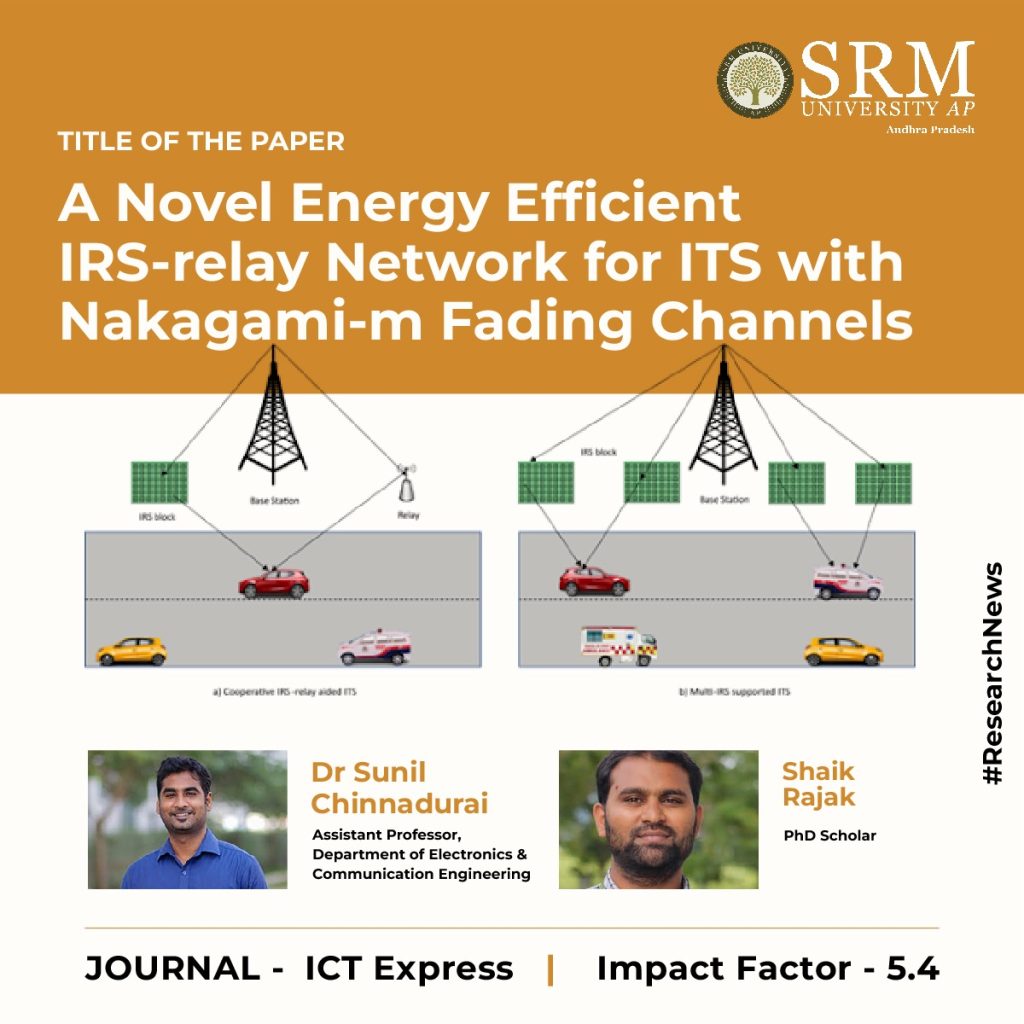
The Department of Electronics and Communication Engineering is proud to announce the publication of a research paper by Dr Sunil Chinnadurai, Assistant Professor and Research scholar Shaik Rajak titled “Novel Energy Efficient IRS-relay Network for ITS with Nakagami-m Fading Channels” in the Q1 journal ICT Express, having an Impact Factor of 5.4. The paper focused on developing an energy-efficient network for ITS that utilises Nakagami-m fading channels to improve communication reliability and efficiency.
In this work, the research duo introduced a cooperative system involving relay technology and an IRS (Intelligent Reflective Surface) with passive elements. Evaluating energy efficiency and achievable rates, they found that the cooperative relay-IRS system outperformed individual relay and IRS setups. The study also compared multi-IRS setups, highlighting their effectiveness in reducing power consumption and deployment costs for improved ITS development.
Abstract
The research paper investigates the performance of energy efficiency (EE) for Intelligent Transportation Systems (ITS) using a cooperative IRS-relay network. The proposed cooperative IRS-relay-aided ITS network integrates an IRS block with a number of passive reflective elements to improve EE. The research analyses the ITS in terms of EE and achievable rate under Nakagami-m fading channel conditions. The research aims to reduce power consumption over long distances and operate the system faster and safer.
Practical implementation/ social implications of the research
The proposed cooperative IRS-relay network for Intelligent Transportation Systems (ITS) has practical implications for improving energy efficiency and achieving higher data rates in ITS networks. Integrating an IRS block with passive reflective elements in the relay model enhances the coverage area and reduces power consumption in ITS. The research highlights the significance of cooperative IRS-relay and multi-IRS-aided networks in the development of ITS, which can contribute to safer and faster transportation.
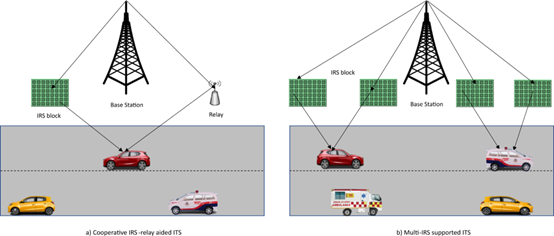
Dr Chinnadurai and Mr Rajak Future will continue to work on their research focusing on optimizing the design of the cooperative IRS-relay network for ITS to improve energy efficiency and achievable data rates further in real-world scenarios.
- Published in Departmental News, ECE NEWS, News, Research News
Physics Duo Publish in Prestigious Journal
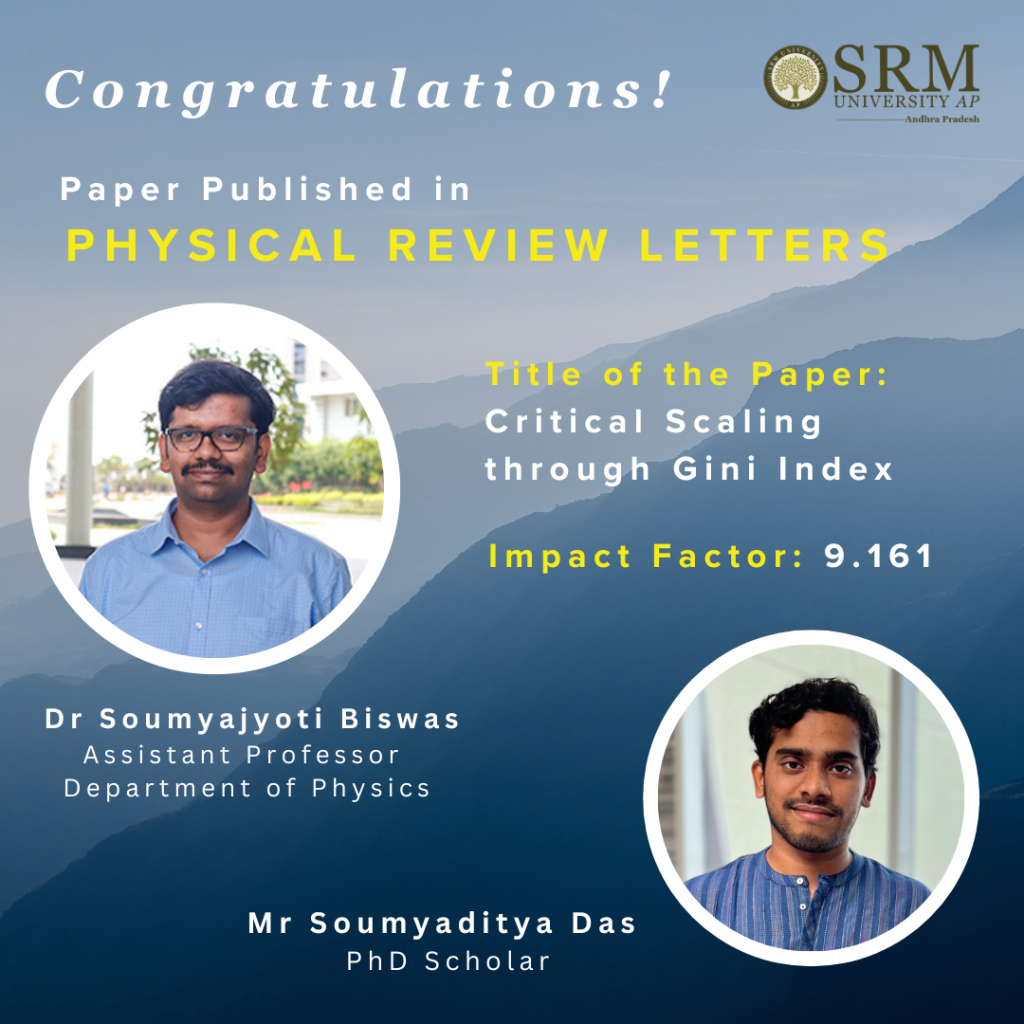
Dr Soumyajyoti Biswas, Assistant Professor in the Department of Physics, along with his Doctoral Scholar, Mr Soumyaditya Das, have presented groundbreaking findings through their research work titled “Critical Scaling through Gini Index”. The research paper was featured in the prestigious Physical Review Letters, which has an impact factor of 9.161.
Abstract
In the systems showing critical behaviour, various response functions have a singularity at the critical point. Therefore, as the driving field is tuned toward its critical value, the response functions change drastically, typically diverging with universal critical exponents. In this Letter, we quantify the inequality of response functions with measures traditionally used in economics, namely by constructing a Lorenz curve and calculating the corresponding Gini index. The scaling of such a response function, when written in terms of the Gini index, shows singularity at a point that is at least as universal as the corresponding critical exponent. The critical scaling, therefore, becomes a single parameter fit, which is a considerable simplification from the usual form where the critical point and critical exponents are independent. We also show that another measure of inequality, the Kolkata index, crosses the Gini index at a point just prior to the critical point. Therefore, monitoring these two inequality indices for a system where the critical point is not known can produce a precursory signal for imminent criticality. This could be useful in many systems, including condensed matter, bio- and geophysics to atmospheric physics. The generality and numerical validity of the calculations are shown with the Monte Carlo simulations of the two-dimensional Ising model, site percolation on the square lattice, and the fibre bundle model of fracture.

Fig.1: Shows the crossing point of the Gini index and the Kolkata index prior to critical point for three different models (from left Ising model in 2d, site percolation in 2d and fiber bundle model of fracture) form both side of critical point.
Collaborations and Future Plans
This work essentially builds a framework for indicating imminent critical points for any system. Therefore, in situations where such knowledge is vital, for example, in the fracture of solids, the method is going to be highly useful in forecasting the failure point. We are in the process of working with our collaborators at the University of Barcelona to experimentally verifying our methods for the compressive failure of porous samples. This is a significant first step towards opening new pathways in forecasting fracture points in disordered materials that could have an impact on laboratory-scale fractures to large constructions and eventually to earthquakes.
We wish the teacher-student duo many more fulfilling and enriching research endeavours in future!
- Published in Departmental News, News, Physics News, Research News
Utilising Social Media Platforms for Crisis Management
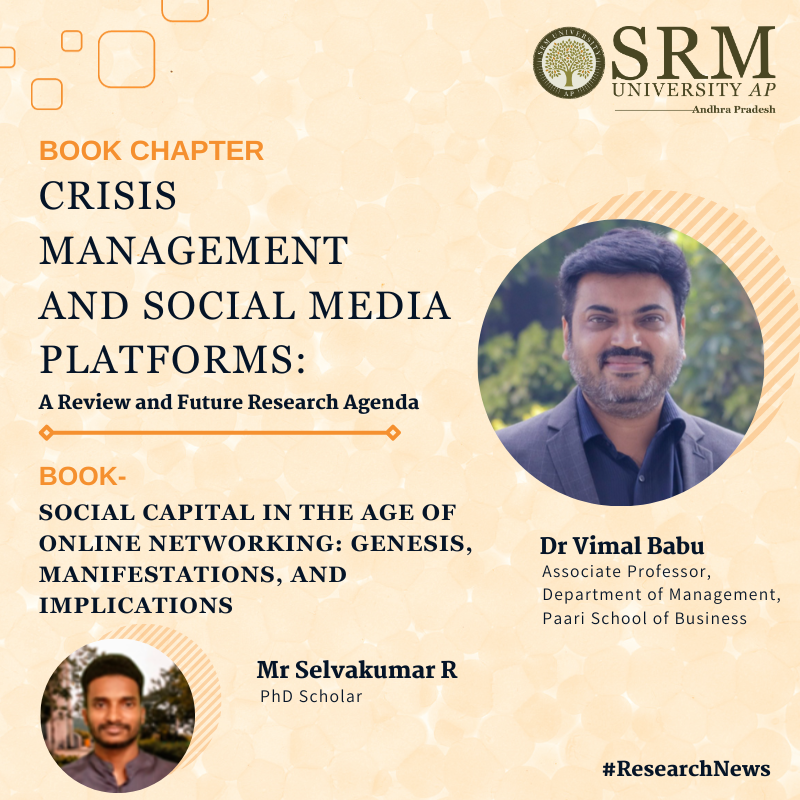
Dr Vimal Babu, Associate Professor and Mr Selvakumar R, Research Scholar from the Department of Management, Paari School of Business has published a fascinating book chapter titled “Crisis Management and Social Media Platforms: A Review and Future Research Agenda” in the book Social Capital in the Age of Online Networking: Genesis, Manifestations, and Implications examining their perspectives on the ever-changing digital ecosystem and its repercussions.
In this chapter, we research duo has made a concerted effort to advance the understanding of crisis management using social media platforms (Social networking sites). Crisis management encompasses a broader spectrum of crisis leadership, and utilising social media platforms (SMPs) for crisis management (CM) has become the modern approach to handling crisis events. Recognising the importance of exploring and advancing crisis leadership concepts to enhance the existing body of knowledge, his work is the first to employ a bibliometric approach to investigate this area, contributing to the nascent literature on the subject. The unique insights garnered from this analysis are expected to provide valuable guidance to researchers and scholars interested in this emerging field.
The book “Social Capital in the Age of Online Networking” digs into the fascinating growth of relationships and connections in the virtual sphere in a digital era when clicks matter as much as handshakes. This edited volume reveals the pattern of our modern networked society, linking theoretical ideas and real-world implementations. The book’s objective is to provide a comprehensive understanding of the current and prospective state of theory and applications of this phenomenon, and it will benefit researchers, government and private research institutions, business corporations, and students in various fields such as business, economics, information technology, psychology, medicine, and humanities.
- Published in Departmental News, News, Paari Current Happenings, Research News
Exploring the Dynamics of Democracy and Foreign Policy
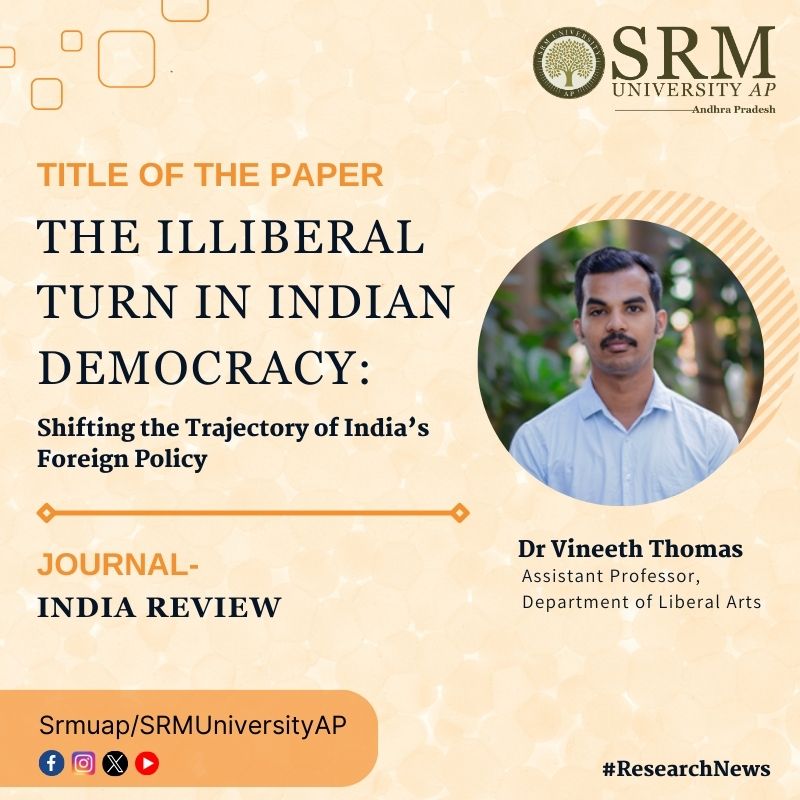
Dive into the intricate realms of Indian democracy and its ever-evolving foreign policy with a compelling research paper by Dr Vineeth Thomas, Assistant Professor, Department of Liberal Arts. The university is happy to announce the publication of Dr Thomas’ latest work, titled “The Illiberal Turn in Indian Democracy: Shifting the Trajectory of India’s Foreign Policy“, in the prestigious Q2 Journal “India Review“.
The paper is a profound exploration of the dynamic shifts in India’s foreign policy, drawing attention to the complexities of the nation’s democratic journey. His research delves into the nuanced interplay of domestic politics and global diplomacy, providing fresh perspectives on the illiberal turn in India’s democratic trajectory. The insightful work takes on a thought-provoking journey into the evolving facets of Indian democracy and the intricate interplay between domestic politics and foreign policy.
Abstract
Long-standing democracies such as India were not exempt from the global trend of democratic retreat. India has come under increasing international attention due to certain domestic policies such as the revocation of Article 370 of the Indian Constitution, the National Register of Citizens and Citizenship (Amendment) Act passed under the Bharatiya Janata Party government. In addition to India’s democratic decline being reflected in global democratic rankings, this has induced strains on India’s foreign relations. In its pursuit of becoming a leading power, India’s perceived democratic backsliding is likely to influence the direction of its foreign policy. To discern the impact of its perceived illiberal turn on its foreign engagement, the role of democracy in India’s foreign policy needs to be explored. While attempts have been made to understand democratic backsliding through a theoretical lens, the impact of a nation’s democratic status on its foreign relations and policy remains a largely unexplored area.
This study will help to understand how India’s democratic backsliding can induce a shift in its foreign policy.
- Published in Departmental News, Liberal Arts News, News, Research News
Exhibition on Design Thinking Projects
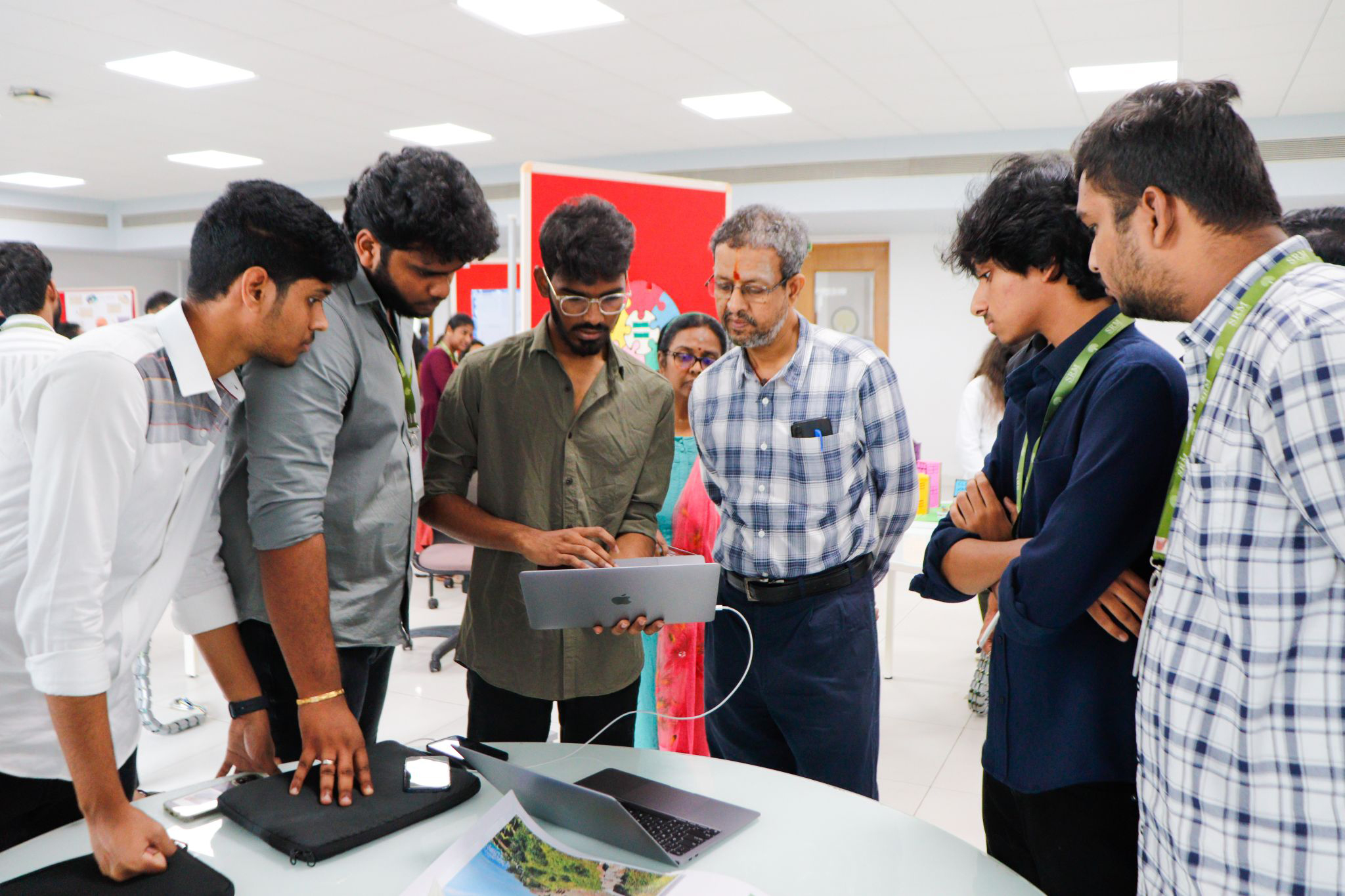
The Paari School of Business organised an exhibition on projects developed by students of the BBA (Hons) programme on the concepts of Design Thinking as a part of their course curriculum. Students exhibited their work to Dr Premkumar R, Registrar; Prof. Bharadhwaj Sivakumaran Dean; Dr Vimal Babu Ph.D. and Mr ARUN PRASAD GS, Faculty of Paari School of Business and students of the varsity.
The exhibition was a successful platform for students to display their knowledge and understanding of Design Thinking and have constructive discourse on this novel and innovative topic!
- Published in Departmental News, News, Paari Current Happenings
Research Fellowship from Humboldt University of Berlin
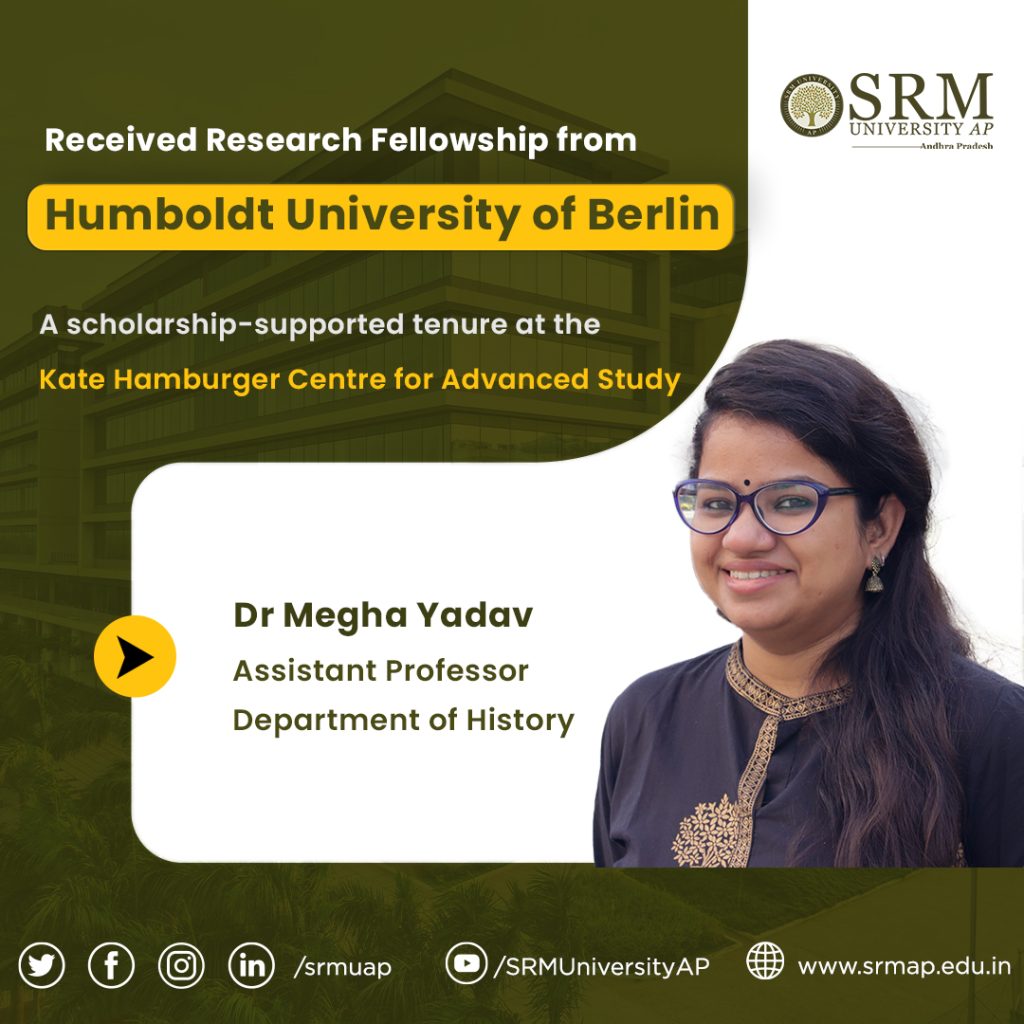
Dr Megha Yadav has received a prestigious fellowship from the Käte Hamburger Centre for Advanced Study, inherit.Heritage in Transformation, Humboldt Universität Zu Berlin, Germany. The fellowship allows for the undertaking of the research project, Visualising the Tradition, Preserving History: Material Practices in Tibetan Buddhism. This project takes an initiative to understand the ideas of heritage and history among the Tibetan Buddhist community by looking at the visual material and its heritage in Tibetan society to reach a nuanced picture of Tibetan history and heritage which keeps the Tibetan community at the centre of this understanding.
The project will attempt to understand the ways and methods of remembrance, preservation, and transmission of what Tibetan Buddhists consider to be their history. Most academic works have utilized Buddhist textual traditions to talk about Tibetan society, which has the inherent limitation of being one-dimensional. As a point of entry, this research will focus on thangka paintings as they create a very intimate window to people’s way of thinking about themselves, their universes, and their personal history. It was a ‘material’ to be showcased in public spaces, notably monasteries. It was meant for everyone to see, pay their respects, and take the image back with them in their minds and hearts. In a sense, these paintings were a showcase for the Tibetan Buddhist community.
This project will also pay attention to the changes brought about by 20th-century events, most notably colonization and the exile of the Dalai Lama and many Tibetans by inquiring into the changes brought into the idea and making of thangka paintings, raising questions about patronage, method, and content in the 20th century. An equally important intervention in the method and content of these paintings came with the spread of digital media platforms. While digital media has ‘democratised’ the making of thangka paintings, the question remains: what has it done to the process of making a thangka? How has the value associated with the paintings, as well as their making process, been changed by the technical medium? Has it impacted the content of these paintings? More importantly, what kind of changes have come into the community’s understanding of their past and present? These and any other issues that may come up during research will be addressed.
- Published in Departmental News, History Current Happenings, History News, News
MSc Environmental Science Students Secure Paid Japanese Internship
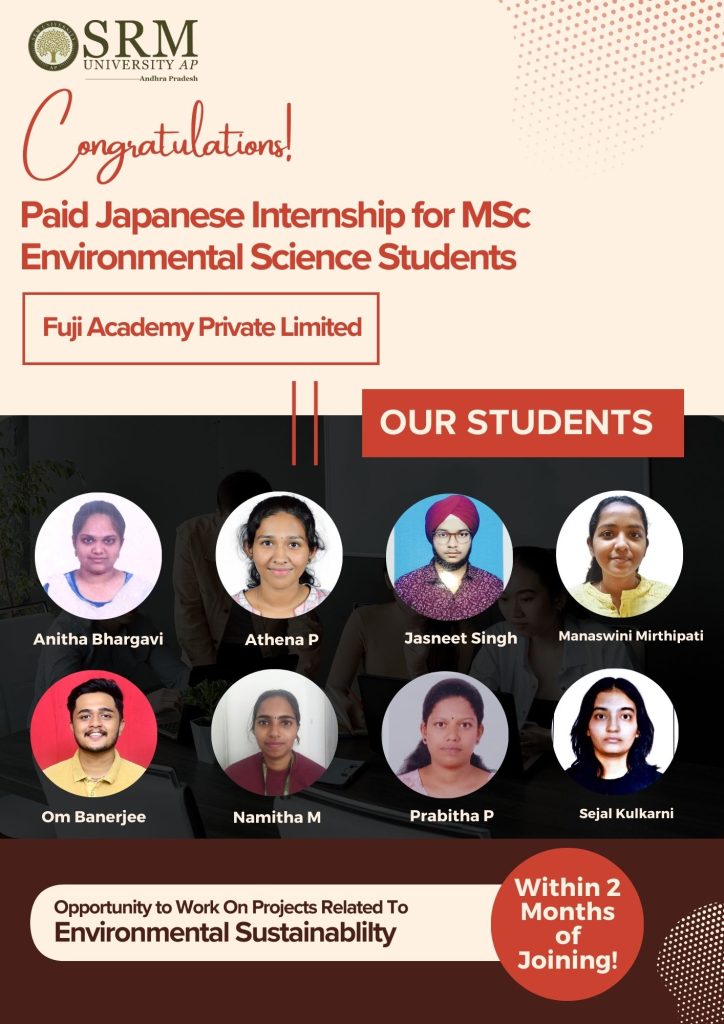
The Department of Environmental Science and Engineering takes pride in announcing that 8 students of MSc Environmental Science programme have bagged a paid internship in the Fuji Academy Private Limited, a prestigious Japanese company. The students shall work on projects related to environmental sustainability and participate in various engaging activities like workshops and training sessions, in addition to networking with different stakeholders in the sustainability sector. It is important to note that the students secured this internship within 2 months of commencing their MSc programme.
- Published in Departmental News, ENVS News, News, Students Achievements
Secularity Unveiled: A Critical Analysis by Prof. Vishnupad
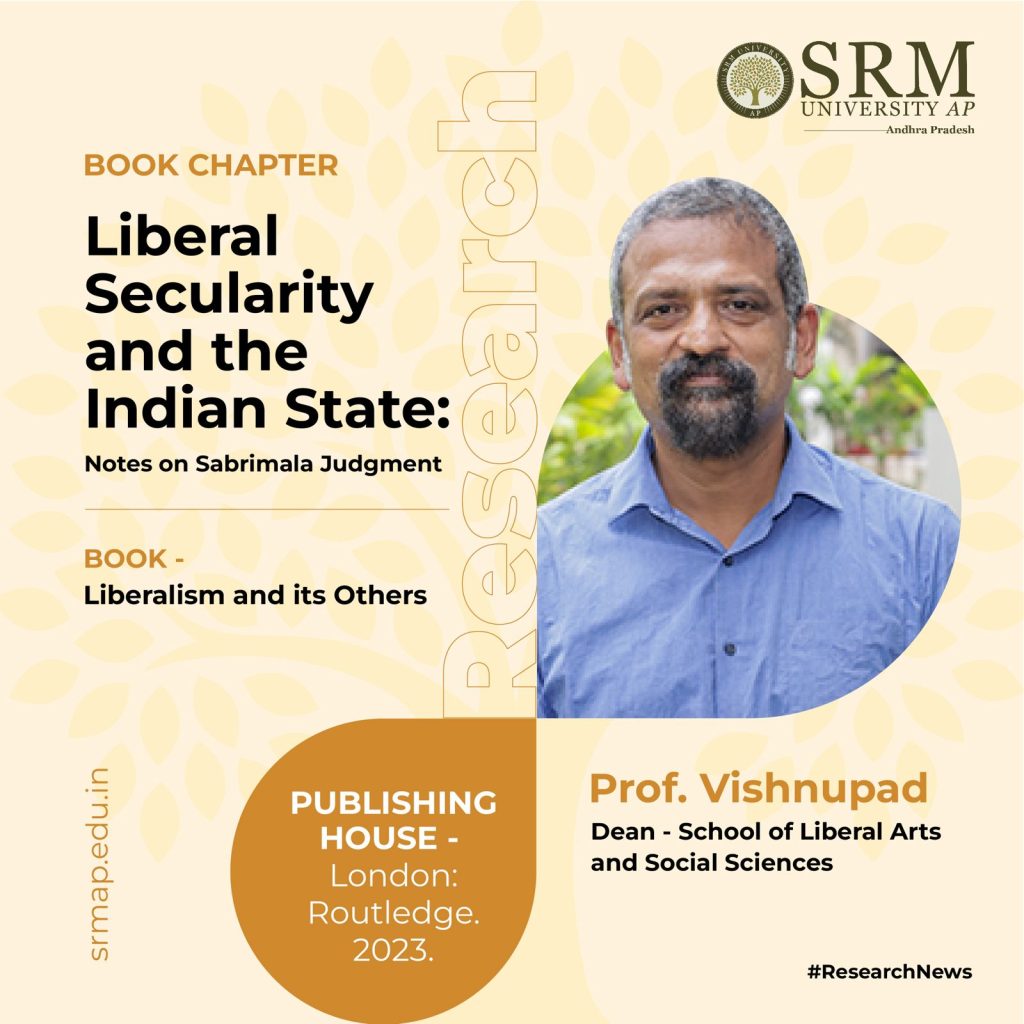
Prof. Vishnupad, Dean – Easwari School of Liberal Arts, has published his latest book chapter, “Liberal Secularity and the Indian State: Notes on the Sabrimala Judgment,” in the prestigious book “Liberalism and its Others”. The intriguing essay explores the complexities of modern secularity in liberal and postcolonial governments and navigates the delicate tango between the political and the religious. The book chapter is a scholarly investigation that maintains the importance of politics over religion while addressing the intricate dynamics of distance to closeness, neutrality to autonomy, and tolerance to publicity. Prof. Vishnupad challenges traditional knowledge, pushing to embrace ethical secularity’s dedication to discourse, transcending political and religious hierarchies.
This stimulating work is a light of intellectual engagement that will affect discussions in the fields of political philosophy, liberalism, and the state’s relationship with religion. Dive deep into these issues as we consider the nexus between politics and faith.
- Published in Departmental News, Liberal Arts News, News, Research News
Innovative Study on Microplastics in Groundwater Published
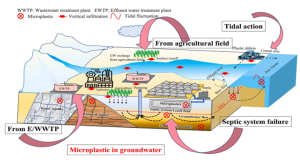 Dr Kousik Das and Dr Deep Raj, Assistant Professors in the Department of Environmental Science and Engineering (EVSE) at SRM University AP, along with Dr Uttiya Dey (Post-doc) and PhD Scholar Mr. Mijanur Mondal, have achieved a significant milestone with the publication of their research paper, “Microplastics in groundwater: An overview of source, distribution, mobility constraints and potential health impacts during the Anthropocene.
Dr Kousik Das and Dr Deep Raj, Assistant Professors in the Department of Environmental Science and Engineering (EVSE) at SRM University AP, along with Dr Uttiya Dey (Post-doc) and PhD Scholar Mr. Mijanur Mondal, have achieved a significant milestone with the publication of their research paper, “Microplastics in groundwater: An overview of source, distribution, mobility constraints and potential health impacts during the Anthropocene.
This pioneering work has been published in the esteemed journal “Groundwater for Sustainable Development,” a Q1 journal with an impressive Impact Factor of 5.9. The paper offers a comprehensive overview of the sources, distribution, mobility constraints, and potential health impacts of microplastics in groundwater, contributing valuable insights to the scientific community.The research team’s dedication to advancing environmental science and addressing crucial issues such as microplastic pollution underscores SRM University AP’s commitment to impactful research and innovation.
Abstract
Microplastics (MPs) are the tiny particles of plastic of > 5 mm in diameter that have already been detected in various environmental matrices like soil, sediment, and surface water, and recently in groundwater also. The occurrence of MPs in groundwater depends up on the transportation through recharge and may controlled by source and local hydrogeology, and partly on the process of surface water-groundwater interaction (SW-GW). Groundwater recharge from agricultural stagnant water, losing streams near dumping sites and agricultural fields, effluents from wastewater treatment plants, septic system failure, etc., are the potential sources of MPs in groundwater. The factors like sea level rise and tidal pumping are among the major factors that may control the migration of MPs in coastal aquifers, along with the physical and chemical properties of the aquifer media. These MPs have another ecological concern as they can adsorb persistent organic pollutants as well as heavy metals and transfer them to animal tissues through the food chain. No such study has been done on the existence, profusion, or environmental factors that contribute to MP pollution in the groundwater in relation to the present climate change scenario. Understanding the extent of MP contamination in groundwater systems is necessary for developing effective management strategies and minimizing their impact on the environment and human health. This study focuses on the source along with the controlling factors of the migration of MPs towards groundwater, including the effect of climate change.
Citation
Dey, U.,Raj, D., Mondal, M., Roy, P., Mukherjee, A., Mondal, N.K. and Das, K. (2023). Microplastics in groundwater: An overview of source, distribution, mobility constraints and potential health impacts during the Anthropocene. Groundwater for Sustainable Development. 23: 101036
Practical implementation and social implications of the research
Microplastic pollution is among the recent emerging pollutants which is still understudied. n. Studies are being conducted mainly focusing the MP contamination in surface water, marine environment and soil, and very limited studies are available to address the source of MPs in groundwater. Even there is lack of standard methods for the effective detection, both qualitatively and quantitatively, of MPs. However, no such study has been done on the existence, profusion, or environmental factors that contribute to MP pollution in the groundwater in relation to the present climate change scenario. As groundwater is a major source of drinking water worldwide, it is of immense importance to enquire more about the source, transport pathways, controlling factors and human health effects of MPs for the safeguard of this valuable resource. Understanding the extent of MP contamination in groundwater systems is necessary for developing effective management strategies and minimizing their impact on the environment and human health. Our study was conducted to mainly focus on the source along with the controlling factors of the migration of MPs towards groundwater including the effect of climate change. The findings of our study would provide valuable insights into the characteristics of MPs in the environment and suggest efforts to mitigate their impact on ecosystems as well as on human health.
Collaborations
The collaborators in this present study are:
- Prof. Abhijit Mukherjee, Department of Geology and Geophysics & School of Environmental Science and Engineering, IIT Kharagpur, West Bengal
- Prof. Naba Kumar Mondal, Department of Environmental Science, The University of Burdwan, West Bengal
Future research plans
Microplastic is one of the recent emerging pollutants which is still understudied. The research has just started to detect MPs in different environmental media as well as to establish effective removal technologies. Our future plans with MP research are as follows:
- To measure the MPs concentration in different coastal areas in India, as the oceans are the major sink for any pollutants, to obtain baseline information about the contamination load
- To detect how much amount of MPs are coming through the major rivers by linking the land use and land cover pattern so that the major sources can be detected
- Detection of MPs in the freshwater aquifer to adopt effective management strategies to safeguard the groundwater
- Development of effective and environment-friendly MP removal technologies
- Published in Departmental News, ENVS News, News, Research News
Leadership Talk by Mr Satakarni Makkapati
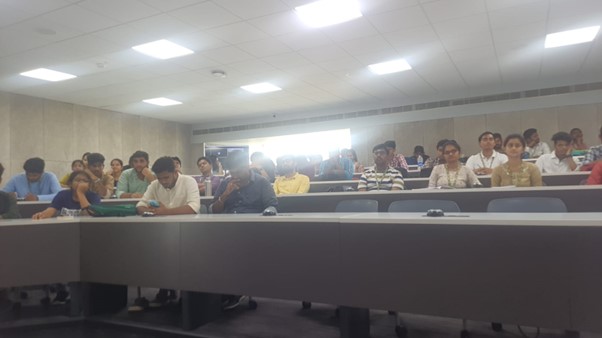
On October 12, 2023, Paari School of Business hosted a Leadership Talk by Mr Satakarni Makkapati, highlighting the critical role of effective leadership in navigating challenges and driving success. Mr Satakarni shared insights on mentorship, change management, the power of teamwork, exercising authority with care, and leading with proactivity, providing invaluable guidance for personal and professional growth.
- Published in Departmental News, News, Paari Current Happenings


